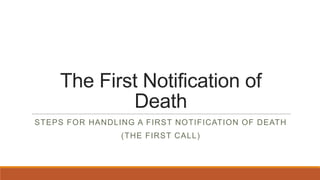
Handle First Death Notification Calls
- 1. The First Notification of Death STEPS FOR HANDLING A FIRST NOTIFICATION OF DEATH (THE FIRST CALL)
- 2. 98% of First Notifications of Death come by way of telephone. It is imperative that all funeral home staff be properly trained to take a first call. This presentation will focus on the steps for taking a first call and for removing the deceased from the place of death.
- 3. First Call Information The Following Information Should Be Obtained When Taking The First Call: Name of deceased Location of deceased Name, and relationship of caller Telephone number of caller Name of next of kin, if not the caller Telephone number of next of kin Name of attending physician Has the physician or medical examiner been notified? ___Yes ___No Age of deceased Permission to embalm obtained? ___Y es ___ No
- 4. First Call Information (cont.) Additionally, If The Deceased Is At A Hospital or Nursing Home: Has a release form been signed? ___ Yes ___ No Will an autopsy be performed? ___ Yes ___ No Is the deceased an organ donor? ___ Yes ___ No Is refrigeration available at the place of death? ___ Yes ___ No Comments: ** one copy of this form should be taken with the person making the removal and one copy should remain at the funeral home **
- 5. When Removing A Deceased From A House: Two funeral home staff members should always go to the house One staff member should stay with the hearse while the other staff member will go to the door, introduce themselves and look at the interior surroundings to see where the deceased is located and if any furniture needs to be moved. Once explanation is given to those present about what will take place, both staff members enter the house with the mortuary stretcher (blanket cover included) and carefully wrap the deceased in a sheet and place on the mortuary stretcher. Family members may wish to assist. All jewelry should be removed by a family member. The deceased is then placed in the hearse and if any furniture was moved or re-arranged, it should be put back in place.
- 6. When Removing A Deceased From A Hospital or Nursing Home: Follow the procedures as set forth by the institution in terms of where to park the hearse, any forms that need to be signed such as release forms or personal affects inventory forms If the family is present, communicate with them just as you would a house call by telling them what will take place.
- 7. Using Proper Technique and Body Mechanics: Always wear gloves Never cover the face of the deceased in the presence of the family Use hand sanitizer once you return to the hearse to leave the place of removal A good, low heel, leather shoe is best to avoid injury from slipping or tripping Knees should always bend when lifting, pushing, or pulling the deceased.
- 8. Dignity, Respect, and Sensitivity If the family is present, offer your condolences and assure them that you and the funeral home will take good care of their loved one. If you received the death certificate, do not discuss the cause of death in the presence of the family. There is no need to ask the cause of death because you will treat every deceased with universal precautions. Remember, regardless of the condition of the home or the circumstances by which the person died, this is somebody’s loved one. Little conversation is best, but be warm and caring.
- 9. Citations All graphics: Microsoft Office ClipArt